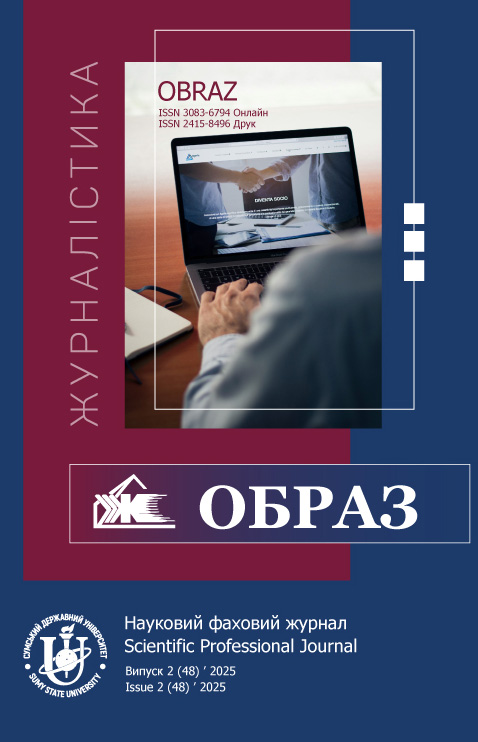Abstract
Introduction. Russia's full-scale invasion of Ukraine has caused significant transformations in the country's media landscape. Traditional media have partially lost their positions, giving way to new communication platforms, particularly messengers. The audience's transition to the Telegram platform has become especially noticeable, as it has become a leading source of information, particularly among young people.
Relevance and Purpose. The relevance of this research is driven by the rapid change in media consumption during wartime and the need to understand new trends in mass communication. The study aims to identify the peculiarities of media consumption transformation among university students and analyze the advantages and disadvantages of Telegram as a dominant information source under martial law.
Methodology. The research is based on a survey of 414 students from Taras Shevchenko National University of Kyiv and Borys Grinchenko Kyiv Metropolitan University. Quantitative analysis methods were used to process survey data and qualitative analysis to determine the characteristics of the Telegram platform.
Results. The study revealed that 93% of surveyed students primarily receive news from social networks, with Telegram being the undisputed leader (89.6%). However, only 40.4% of respondents trust social networks as an information source. Notably, 29.8% of users don't know the owners of any information channels they use. The main advantages of Telegram (speed, functionality, accessibility) and disadvantages (information verification issues, lack of accountability, security risks) were identified.
Conclusions. The research confirms a radical change in young people's media content consumption during wartime. Telegram has become the dominant platform for news consumption, displacing traditional media. However, low trust levels and a significant number of anonymous sources create information security risks. This necessitates developing new approaches to media regulation and improving audience media literacy.
References
1. "How Non-Institutionalized News Telegram Channels of the Ukrainian Segment Function and Gain Audience. Analytical Report." Kyiv, NGO "Ukrainian Institute of Media and Communication", 2023.
2. Ghasiya, P., & Sasahara, K. (2023). Messaging Strategies of Ukraine and Russia on Telegram during the 2022 Russian invasion of Ukraine. First Monday.
3. Ptaszek, G., Yuskiv, B., & Khomych, S. (2024). War on frames: Text mining of conflict in Russian and Ukrainian news agency coverage on Telegram during the Russian invasion of Ukraine in 2022. Media, War & Conflict, 17(1), 41-61.
4. Nazaruk, T. (2022). Subscribe and follow. Telegram and responsive archiving the war in Ukraine. Sociologica, 16(2), 217-226.
5. Farbman, S. (2023). Telegram, 'milbloggers' and the Russian State. Survival. Routledge. 107-127.
6. Hurzhii, S. (2021). Modern threatening trends in the use of Telegram channels to the detriment of state interests. Information and Law, (4(39)), 162-169.
7. Katerynych, P., Dubrovskyi, R. & Kindras, I. (2023). Hate speech in journalistic discourse (based on Telegram texts). Scientific Notes of V.I. Vernadsky Taurida National University. Series: Philology. Journalism, 34(73), No. 1, 170-176.
8. Mysechko, A. (2022). The role of audiovisual component of social networks in the fight against Russian occupiers. Science, Education, Technology and Society: New Research and Perspectives, 78.
9. Hrysiuk, V., Volutsa, L. (2023). The state of military journalism under conditions of Russia's full-scale war against Ukraine. Editorial Board, 287.
10. Butyrina, M. (2020). Telegram channel as meta-media: communication features. Society and Personality in Modern Communication Discourse: Proceedings of the II All-Ukrainian Scientific-Practical Conference, 138-141.
11. Plakhta, D. (2020). Telegram as a tool for political influence and manipulation. TV and radio journalism. Issue 19. 88-94.
12. Zhuhai, V., & Kuznietsova, T. V. (2021). Features of Telegram channels as newest media tools: Ukrainian context. Scientific Notes of V.I. Vernadsky Taurida National University. Series: Philology. Journalism, 6(3), 120-125.
13. Hulai, V., & Vorobets, Yu. (2020). Telegram channels as a tool of manipulative influence on public opinion formation (on the example of Ukraine and Russia). Scientific Bulletin of Lesya Ukrainka East European National University. International Relations.
14. Hrysiuk, V. P. (2023). Media Law and Information Security: Media Law and Intellectual Property Protection.
15. Mialkovska, L., Hrysiuk, V., Zhvania, L., Nykoliuk, T., Tykha, L., Sadova, L., & Yablonskyy, M. (2024). Leveraging Media and Public Relations Strategies to Advance Sustainable Development: Approaches, Frameworks, and Tactics in Modern Conditions. Journal of Natural Resources, 7(3), s253-s269.
16. Hrysiuk, V., & Efimova, M. (2025). The Popularity of Media Platforms in the Context of the Russian-Ukrainian War: Survey Results. Current Issues of Media Space: Book of Abstracts (2025). Kyiv–Viterbo. 480 p.

This work is licensed under a Creative Commons Attribution 4.0 International License.

